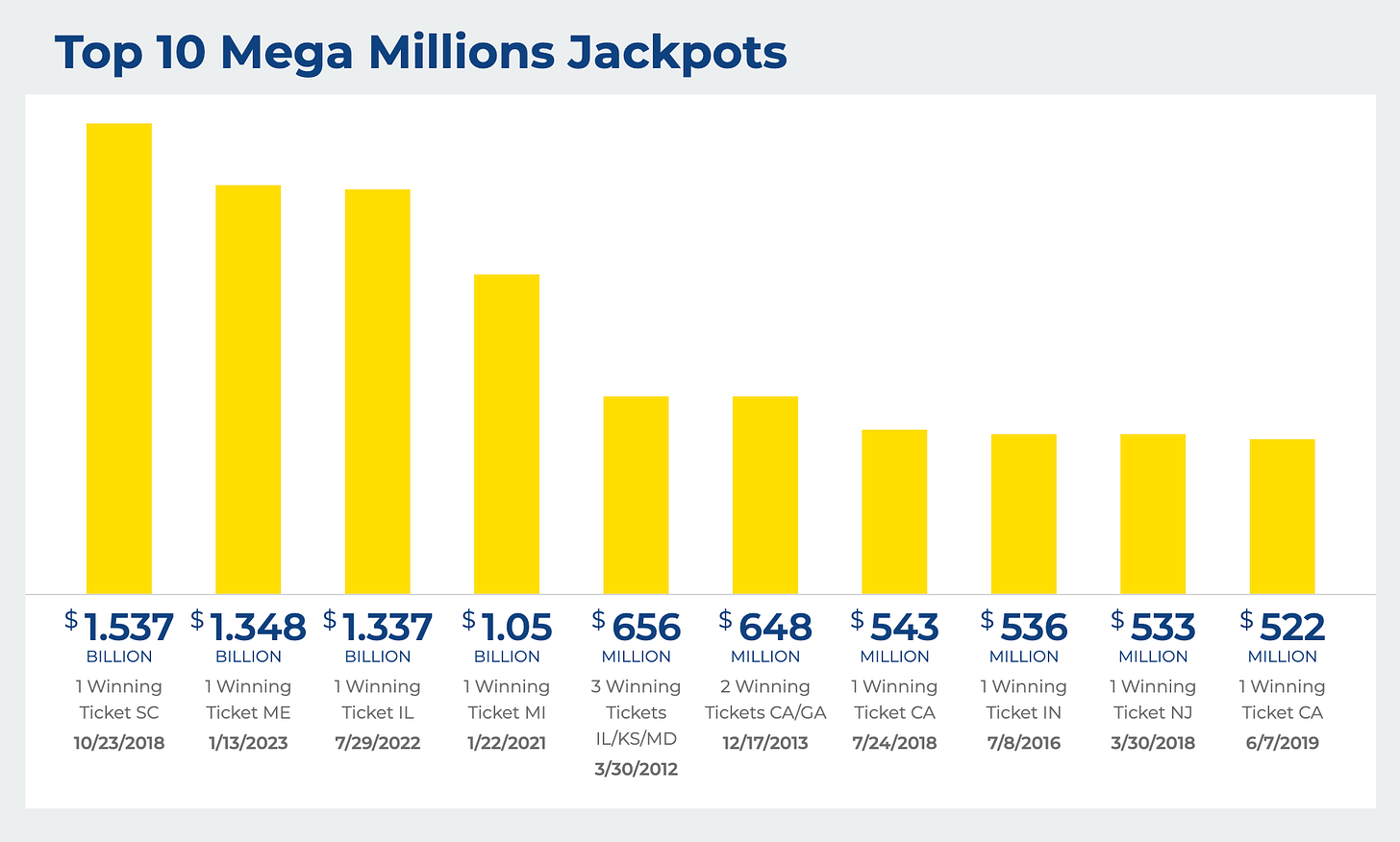To investors,
Gambling is an American tradition. More specifically, the lottery has been a core component to funding the rise of America and many of our most respected institutions.
The Virginia Company of London created the first lottery in America in 1616 to raise money for ventures chartered by King Charles, including the establishment of the first permanent settlement in Jamestown, Virginia.
Over time, all 13 of the original colonies established their own lotteries with the goal of raising money for their operations. Given where the money was going, it became a civic responsibility to play the lottery.
The lotteries didn’t stop there. These games have been used to fund churches, libraries, and various prestigious universities including Harvard, Yale, Columbia, Dartmouth, and Princeton.
Lotteries have evolved over the years and now jackpots are reaching more than $1 billion. That seems insane, but why is it happening?
The rules have changed and now millions more people can participate in a single lottery drawing. The more people who are playing, as long as no one wins the pot of money, gives fuel to a larger and larger amount up for grabs.
There are two types of lotteries in the United States — state lotteries and multi-jurisdictional lotteries. State lotteries can only be played within the state borders and the winning ticket must be redeemed there as well. Multi-jurisdictional lotteries are available across multiple states.
The state lotteries are usually smaller in size because fewer people are eligible to play them. The multi-jurisdictional lotteries are where the $1+ billion winning pots have been accumulated.
There are two main lottery brands — Powerball and Mega Millions.
According to the Powerball website, they have raised more than $29 billion for public programs and services. Here is how it works:
“Powerball tickets are $2 per play. Tickets are sold in 45 states, the District of Columbia, Puerto Rico and the U.S. Virgin Islands. More than half of all proceeds from the sale of a Powerball ticket remain in the jurisdiction where the ticket was sold. Drawings are broadcast live every Monday, Wednesday and Saturday at 10:59 pm ET.
Players select five numbers between 1 and 69 and one Powerball number between 1 and 26.
The Powerball jackpot grows until its won. Players win a prize by matching one of the 9 ways to win. The jackpot is won by matching all five white balls in any order and the red Powerball.”
The 10 largest jackpot winnings range from $2 billion to $632 million.
$2.040 Billion
$1.586 Billion
$1.080 Billion
$768.4 Million
$758.7 Million
$754.6 Million
$731.1 Million
$699.8 Million
$687.8 Million
$632.6 Million
Mega Millions is slightly less popular, but they have been the recipient of a number of large jackpots as well.
These jackpots are measured in hundreds of millions or billions of dollars, so where exactly does all this money go? The answer, as with most things in life, is it depends. Each lottery system is a little different and each state treats the lottery revenue in a different way.
Generally, here is a breakdown of where the funds go:
50% goes to the lottery winner
10% goes to administrative costs
5% is commissions to retailers who sell lottery tickets
35% is divided among states based on pro-rata ticket sales
The amount of money given to the states is where things get interesting. Each state can receive tens of millions of dollars on the larger jackpots, so they have to decide what to do with that money.
California, as an example, is exclusively focused on funding educational efforts, while Arizona supports the following programs:
Education
General Government
Health and Welfare
Inspection and Regulation
Natural Resources
Protection and Safety
Commerce Authority Arizona Competes Fund
Court Appointed Special Advocate Fund (Unclaimed prizes)
Dept of Gaming
Healthy Arizona
Heritage Fund
Homeless Shelters
General Fund (by Category)
Mass Transit
University Bond Fund
Automation Projects Fund
Internet Crimes Against Children Victims' Rights
Internet Crimes Against Children Victims
Tribal College Dual Enrollment Program
Most people look at the lottery as a dumb game that is a tax on the unintelligent. There is a hint of truth to that thought process. Gambling addiction is real and every state sinks significant resources into addiction hotlines or other combative measures.
Lotteries have also been apart of American culture since the founding of our country. They have helped to fund early settlements, well-respected institutions, and various public services in modern times.
With billion dollar jackpots happening more frequently due to multi-jurisdiction games, the lottery has become a big business. In fact, it is so big that the business and investing world will have a hard time ignoring it in the future.
Hope you all have a great day. I’ll talk to you tomorrow.
-Pomp
Darius Dale is the founder & CEO of 42Macro.
In this conversation, we talk about the S&P 500, bitcoin, consumer spending, manufacturing, capacity utilization, and what will the Fed do with interest rates later this year?
Listen on iTunes: Click here
Listen on Spotify: Click here
Earn Bitcoin by listening on Fountain: Click here
Darius Dale Breaks Down A Strong Consumer and Soft Manufacturing Data
Get Better Crypto Data: Do you want faster, easier crypto data? Sign up for Velo Data, a new product that we have been working on to solve this problem: velowaitlist.com 🚨
You are receiving The Pomp Letter because you either signed up or you attended one of the events that I spoke at. Feel free to unsubscribe if you aren’t finding this valuable. Nothing in this email is intended to serve as financial advice. Do your own research.













Share this post